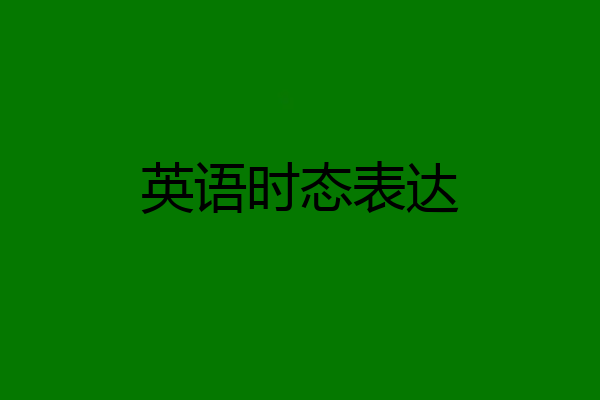
秀之美--艳梅
英语中有16种时态1.一般现在时 the present tense 2.一般过去时 the past tense3.一般将来时 the future tense4.一般过去将来时 the past future tense 5.现在进行时 the present continuous tense6.过去进行时 the past Continuous Tense 7.将来进行时 the future continuous tense 8.过去将来进行时 the past future continuous tense9.现在完成时 the Present Perfect Tense 10.过去完成时 the Past Perfect Tense 11.将来完成时 the future perfect tense 12.过去将来完成时 the past future perfect tense 13.现在完成进行时 the present perfect continuous tense 14.过去完成进行时 the past perfect continuous tense15.将来完成进行时 the future perfect continuous tense 16.过去将来完成进行时 the past future perfect continuous tense


沙土花生
英语的时态(tense)是一种动词形式,不同的时态用以表示不同的时间与方式. 是表示行为、动作和状态在各种时间条件下的动词形式.因此,当我们说时态结构的时候,指的是相应时态下的动词形式. 英语时态分为16种:一般现在、一般过去、一般将来、过去将来时,以及这四者的进行时、完成时和完成进行时 下面就英语中常见的八种基本时态进行阐述,其它的时态都是在这八种时态的基础上结合而成的. 一、 一般现在时 1.概念:经常、反复发生的动作或行为及现在的某种状况. 2.时间状语: always, usually, often, sometimes, every week (day, year, month…), once a week, on Sundays, 3.基本结构:动词 原形 (如主语为第三人称单数,动词上要改为第三人称单数形式) 4.否定形式:am/is/are+not;此时态的谓语动词若为行为动词,则在其前加don't,如主语为第三人称单数,则用doesn't,同时还原行为动词. 5.一般疑问句:把be动词放于句首;用助动词do提问,如主语为第三人称单数,则用does,同时,还原行为动词. 6.例句:. It seldom snows here. He is always ready to help others. Action speaks louder than words.. 二、 一般过去时 1.概念:过去某个时间里发生的动作或状态;过去习惯性、经常性的动作、行为;表示客观规律和永恒真理等. 2.时间状语:ago, yesterday, the day before yesterday, last week,last(year, night, month…), in 1989, just now, at the age of 5, one day, long long ago, once upon a time, etc. 3.基本结构:be动词;行为动词 的过去式 4.否定形式:was/were+not;在行为动词前加didn't,同时还原行为动词. 5.一般疑问句:was或were放于句首;用助动词do的过去式did 提问,同时还原行为动词. 6.例句:She often came to help us in those days. I didn't know you were so busy. 三、 现在进行时 1.概念:表示现阶段或说话时正在进行的动作及行为. 2.时间状语:now, at this time, these days, etc. 3.基本结构:am/is/are+doing 4.否定形式:am/is/are+not+doing. 5.一般疑问句:把be动词放于句首. 6.例句: How are you feeling today? He is doing well in his lessons. 四、 过去进行时 1.概念:表示过去某段时间或某一时刻正在发生或进行的行为或动作. 2.时间状语:at this time yesterday, at that time或以when引导的谓语动词是一般过去时的时间状语等. 3.基本结构:was/were+doing 4.否定形式:was/were + not + doing. 5.一般疑问句:把was或were放于句首. 6.例句:At that time she was working in a PLA unit. When he came in, I was reading a newspaper. 五、 现在完成时 1.概念:过去发生或已经完成的动作对现在造成的影响或结果,或从过去已经开始,持续到现在的动作或状态. 2.时间状语:recently, lately, since…for…,in the past few years, etc. 3.基本结构:have/has + done 4.否定形式:have/has + not +done. 5.一般疑问句:have或has. 6.例句:I've written an article. The countryside has changed a lot in the past few years. 六、 过去完成时 1.概念:以过去某个时间为标准,在此以前发生的动作或行为,或在过去某动作之前完成的行为,即“过去的过去”. 2.时间状语:before, by the end of last year(term, month…),etc. 3.基本结构:had + done. 4.否定形式:had + not + done. 5.一般疑问句:had放于句首. 6.例句:As soon as we got to the station, the train had left. By the end of last month. We had reviewed four books 基本结构:主语+have/has+过去分词(done) ①肯定句:主语+have/has+过去分词+其他 ②否定句:主语+have/has+not+过去分词+其他 ③一般疑问句:Have/Has+主语+过去分词+其他 ④特殊疑问句:特殊疑问词+一般疑问句 [编辑本段]七、 一般将来时 1.概念:表示将要发生的动作或存在的状态及打算、计划或准备做某事. 2.时间状语:tomorrow, next day(week, month, year…),soon, in a few minutes, by…,the day after tomorrow, etc. 3.基本结构:主语+am/is/are+going to + do;will/shall + do. 4.否定形式:am/is/are not going to do ;will/shall not do. 5.一般疑问句:be放于句首;will/shall提到句首. 6.例句:They are going to have a competition with us in studies. It is going to rain. 八、 过去将来时 1.概念:立足于过去某一时刻,从过去看将来,常用于宾语从句中. 2.时间状语:the next day(morning, year…),the following month(week…),etc. 3.基本结构:was/were/going to + do;would/should + do. 4.否定形式:was/were/not + going to + do;would/should + not + do. 5.一般疑问句:was或were放于句首;would/should 提到句首. 6.例句:He said he would go to Beijing the next day. I asked who was going there . 九、将来完成时 1.概念:在将来某一时刻之前开始的动作或状态 2.时间状语:by the time of;by the end of+时间短语(将来);by the time+从句(将来) 3.基本结构:be going to/will/shall + have done 4例句:By the time you get back,great changes will have taken place in this area. 十、现在完成进行时 1.概念:在过去某一时刻之前开始的动作或状态一直持续到说话为止 2.基本结构:have/has +been+doing 几种常见时态的相互转换

油墩子2016
最多16种的. 英语总共有16个时态. 为了让人容易理解与记忆,我把它们整理如下: 1.现在式: 一般时(例:he works hard表示他工作努力) 进行时(例:he is reading表示他正在阅读) 完成时(例:he have finished it表示他已完成了) 完成进行时(例:he have been writting it for two hours表示他已经写了两个小时了) 2.过去式: 一般时(例:he worked hard表示他过去工作很努力) 进行时(例:he was reading last night表示他昨晚在阅读) 完成时(例:he had finished it since you arrived.表示在你到达之前他已完成) 完成进行时(例:he had been writting it表示他过去就已经在写了) 3.将来式: 一般时(例:he will work hard表示他将努力工作) 进行时(例:he will be reading表示他将会阅读的) 完成时(例:he will have finished it by the time of tomorrow表示明天之前他将完成) 完成进行时(例:he will have been staying there for ten years by the time of next month表示到下个月,他将呆在那儿十年了) 4.过去将来式 一般时(例:he would work hard表示他过去工作努力) 进行时(例:he would be working hard表示他过去一段时间在努力工作着) 完成时(例:he would have finished it by the last month表示他到上个月为止就将完成任务) 完成进行时(例:he would have been staying there for ten years by the time of last month表示到上个月为止,他在那里差不多呆了十年之久) 区别与联系: 现在一般时与现在完成时 1.I come from Shanghai(上海人) I have come from Shanghai(从上海来) 2.You read very well.(强调能力) You've read very well.(强调一次刚完成的动作) 3.I forget.(一时想不起来了) I have forgotten.(仍没想起来,可能已回忆起来了 现在一般时与现在进行时 1.He works hard.(强调始终如一)He is working hard.(强调现在) 2.What do you do?(干什么工作的)What are you doing?(在干什么) 3.Here comes the bus!(表高兴和欣慰) The bus is coming.(汽车到来的情景) 现在完成时与过去一般时 1.I've seen him this morning.(还在上午的时间里) I saw him this morning.(时间已不在上午了) 2.Who's opened the window?(窗户还在开着) Who opened the window?(与现在无关,窗户可能已关上) 3.Have you ever heard him sing?(他可能不是爱唱歌) Did you ever hear him sing?(你曾听过他唱歌吗,他可能是歌唱家) 过去完成时与过去一般时 1.I came here after I finished middle school.(两个动作每间隔) I came here after I had finished middle school.(两个动作有间隔,强调先后概念) 2.I waited till I saw him. I waited till I had seen him.(这两个句子差不多,过去完成时更普遍) 3.We hoped he would come.(我们希望他来) We had hoped he would come.(我们本希望他来的) 过去进行时与过去一般时 1.I read a book yesterday.(书已看完) I was reading a book yesterday.(书尚未看完) 2.The guests arrived.(客人已到) The guests were arriving.(客人陆续到达) 3.He woke from a dream.(表示全醒) He was waking from a dream.(表示初醒) 将来一般时与现在进行时 1.Will he come?Is he coming?(时间发生的比较近) 2.She'll have a baby.(表示肯定) She's going to have a baby.(表示推测,计划) 3.I'll see him this evening.(表示意愿) I'm seeing him this evening.(表示打算,已有安排) 现在一般时与过去一般式 1.Do you wish to see me? Did you wish to see me?(表示婉转客气) 2.That's all I have to say.(我的话就这些) That's all I had to say.(我要说的就这些) 3.How do you like the film?(看电影过程中) How did you like the film?(看完电影后) 现在完成时与现在完成进行时 1.Someone has phoned you.(打了电话) Someone has been phoning you.(一直在打电话) 2.I've read the novel.(已读完) I've been reading the novel.(还没读完) 3.He has lived here for six weeks. He has been living here for six weeks.(区别不大,后者更口语化) 现在一般时与过去完成时 1.I hope that he'll come. I had hoped he would come.(与事实相反) (经常这样用的词有:expect,think,intend,mean,suppose) 英语之中之所以有那么多时态,是因为英语这种语言非常重视时间与时间的相对关系,比如:现在,过去,将来,相对于现在的过去与将来,相对于过去的过去与过去的将来,相对将来的过去与现在等等,所以在理解时态的时候,一定要注意主语的动作是相对于某个动作的哪一个时间或时间段来说的,相对于不同的时间段用不同的时态表示,这样才比较容易理解时态的一般情况与特殊情况.

贝贝塔11
各种时态的英文表达方式
1.一般现在时the present tense
2.一般过去时the past tense
3.一般将来时the future tense
时态(tense)是一种动词形式,不同的时态用以表示不同的时间与方式。它是表示行为、动作、状态在各种时间条件下的动词形式,在英语中有16种时态。
下面就英语中常见的十种基本时态进行阐述,其它的时态都是在这十种时态的基础上结合而成的。
在语法里,时或时态表示行为发生的时间和说话时的关系。一般分为过去式、现在式、将来式,通常也有与表示动作进行或终止的进行式和完成式等体貌一起相连用的情况。
时态连同语气、语态、体貌和人称为动词形式至少可能能够表现出的5种语法特性。
有些语言,没有时态的使用,如分析语的中文,但必要时,仍有时间副词的辅助。也有些语言,如日文,形容词的词形变化能表达出时间上的资讯,有着类似动词的时态性质。还有些语言,如俄文,一个单词就能表现出时态和体貌。
优质英语培训问答知识库